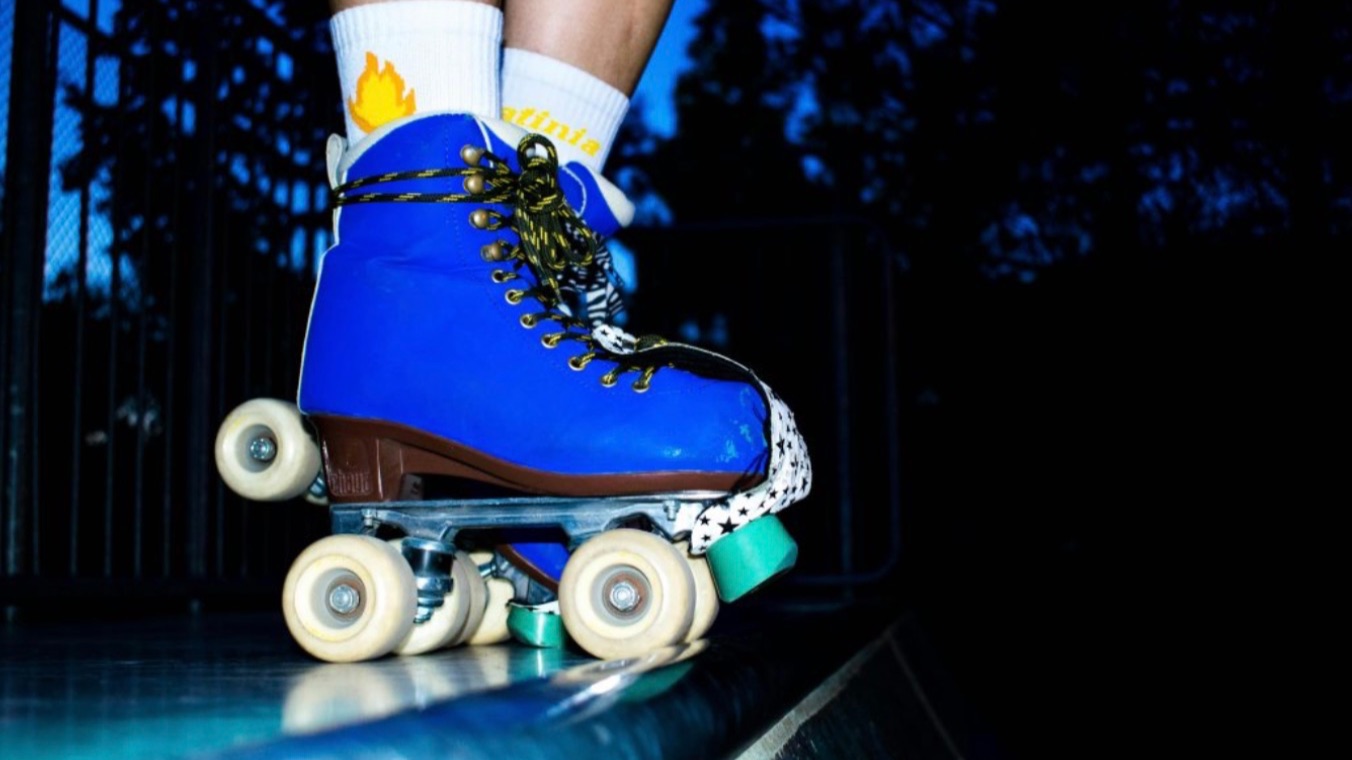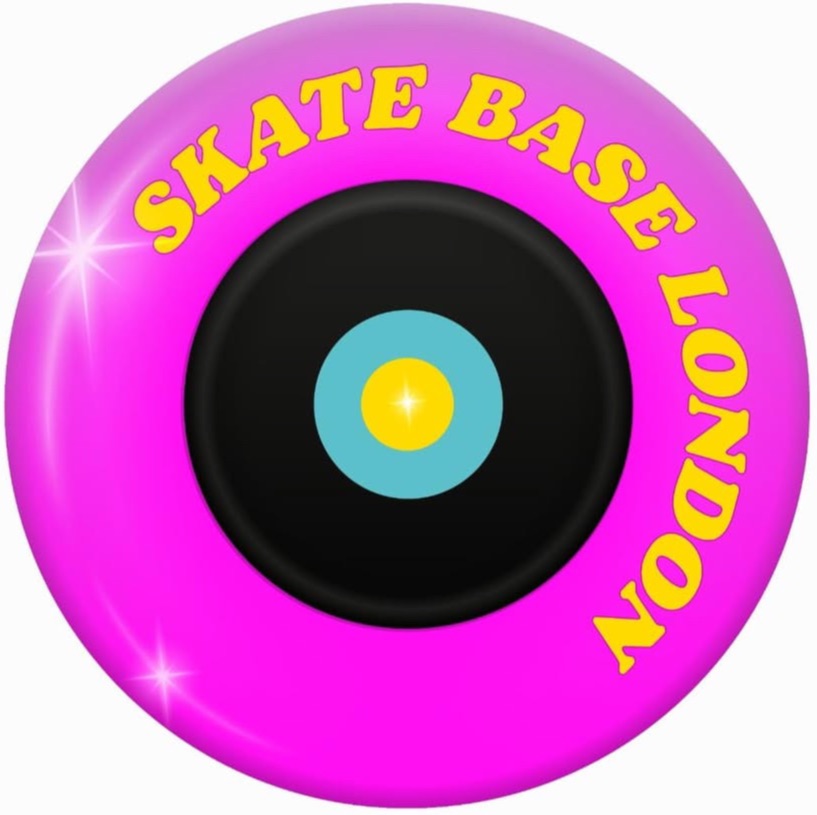
Are you an adult who is interested in roller skating? Are you also unsure of which one of the various roller skating styles to start with? Read on for a brief exploration of UK roller skating styles.
Roller Skating Styles: Artistic skating
Artistic roller skating is a competitive sport performed on roller skates. It’s one of the most well-known roller skating styles which combines elements of traditional roller skating with elements of dance, acrobatics, and figure skating. It is typically performed on a rink and can be done as part of a skating team or as a solo event.
There are four distinct disciplines of artistic roller skating: dance, figures, freestyle, and pairs. Dance is skating as a solo or in a group in time to music. Figures are set moves and patterns that are performed on a perfectly round and smooth track (you may have seen them painted on the rink floor). Freestyle is a combination of jumps, spins, and steps. Pairs involve two skaters performing a synchronized artistic routine.
To participate in artistic roller skating, you will need regulation roller skates that fit properly and are the correct size for you. These are normally hard artistic roller skating boots with ankle support. It is recommended that you take lessons from a qualified instructor as this style of roller skating requires a skillset which can be highly challenging. You may join a skating school or class, or you may take private lessons.

Roller Skating Styles: Recreational Skating
Recreational skating is can be one of the least challenging and more leisurely roller skating styles to learn and enjoy, but it really depends on your approach! It can be as easy as skating around your local park on your own, (in quad or inline skates), learning a few fun moves alongside other roller skating enthusiasts at your local skating rink or a rigorous past time which you invest a lot of your time and energy. You’ll need a pair of decent roller skates as well as appropriate protection such as knee pads, elbow pads and wrist guards to reduce the injury risk. Let’s look more closely at a few of the recreational roller skating styles which are increasing in popularity here in London.
Rhythm skating
Rhythm skating is a form of skating which focuses on the elements of music and skating in tandem. Rhythm skating aims to smoothly connect steps, spins and turns in a sequence that is synchronised with a piece of music. Rhythm skating has its emphasis on the performance and expression of the music through skating steps rather than the athleticism of performing big jumps.
Rhythm skating consists of a variety of moves, including crossover steps, moon walking, various types of spins, spirals, footwork sequences, and linking steps. Skaters strive to add their own unique expression and personality to their rhythm performance.
Learning the basics of rhythm skating is possible with the help of a few more experienced friends or a rhythm skating teacher. Having someone who is more experienced than you can vastly accelerate your development of the basic skills, discipline, and artistry needed to excel in rhythm skating. You may also want to explore beginner level classes and practise sessions that exist in various skating rinks.
Jam skating
Jam skating is one of several dynamic roller skating styles. It’s a recreational style which requires a good degree of roller skating skill, strength, agility, balance, and creative expression. Jam skaters need to be proficient in skills such as turning, balancing, stopping and skating backwards. They’re often able to do flips, kip ups, handstands, front splits, a range of spin combinations, and other acrobatic movements. Jam skating is a form of freestyle street skating that combines elements of hip hop dance in an improvisational fashion.
Jam skating began in the 1970s with a style of skaters called The Soul Skaters who moved to the beat of funk and soul music.
Jam skating has its roots in the early days of the roller disco era, when people began to break away from the traditional dance-style roller skating and began to explore more creative ways of skating. Hip hop music provided the perfect opportunity for skaters to express themselves while still staying true to their roots.
Hip hop has had a major influence on the development of jam skating since then, with skaters incorporating various hip hop dance moves into their routine.Jam Skaters combine skate dancing, gymnastics, and acrobatics and hip hop moves to create dynamic routines and “skits” using roller skates as an extension of their body movements.
Jam skaters usually use roller skates with a hard supportive boot, steel wheel plates, and smaller wheels (for more intricate movement control). Here in London, jam skaters tend to switch there toe stops for jam plugs to increase the depth of their toe pivots to for a more dynamic and expressive movement style. Clothing should be comfortable and form-fitting so the skaters can move freely and safely.
Jam skating is becoming increasingly popular worldwide, with communities and groups forming to learn and practise with one another. Check your local area for skateparks, indoor rinks, or jam skating classes. You can also take online lessons or connect with online communities to find other jam skaters near you. Its a great way to share tips, tricks, and creative ideas.
Ballroom Skating
Ballroom skating is one of the roller skating styles that incorporates traditional ballroom dance elements. It is a discipline that has been influenced by pairs ice dancing that has been gaining in popularity over the past few years. Ballroom skating combines the skill of roller skating with the grace, elegance and synchronicity of ballroom dance. It is a unique way for skaters to express themselves both artistically and athletically.
Ballroom skating includes elements such as footwork, spins, turns, dips, edge work and at its highest level, lifts. These elements combine to create a graceful performance that showcases the skater’s artistry and skill. Ballroom skaters must also perform in synchronisation with a partner, while keeping the tempo, rhythm and expression of the music. Ballroom skating is less of an athletic display and more of an artistic performance. It adds the elegance and style of dance
To get started with ballroom skating, you will need a pair of roller skates, a skate partner, and music choices that will allow you to show off your elegance as you skate. It is also helpful to have an instructor who can help you develop the specific skills necessary for ballroom skating.
To become a successful ballroom roller skater, it is important to have a good foundation in general skating technique, including basic footwork, basic spins, as well as good control over your roller skate edges and musical timing.
Street skating
Street skating is a form of recreational skating where skaters enjoy roller skating outside for fun, fitness, or as a means of getting from one place to another. In London, street skating is a roller skating style enjoyed solo and in groups.
Street skating in large groups can offer an additional degree of safety (due to increased visibility of skaters), support and opportunity network and become more immersed into the skate community. On a typical group street skate, skaters will utilise pavements, bus lanes and quiet roads to get around. They’ll typically play music within the group (carrying one or more portable speakers) and enjoy skating backwards periodically as they go.
Street skating will often require you to change direction and stop quickly and easily! You’ll need to have confidence on the road to navigate your way around pedestrians on pavements. It’s also imperative that you are able to step up and down curbs and steps confidently.
Street skaters will often wear some form of protective padding, like knee pads, elbow pads, and/or wrist guards. Additionally, protective eyewear may be beneficial to protect your eyes from debris and dust. If the weather is cold or you’re skating at night, you may also consider wearing gloves and a jacket with reflective material for increased visibility.
London has recently (since UK lockdown) seen an increase in numbers of people learning to Street skate. The trend now is to wear Bauer ice hockey boots that have been converted into quad roller skates. These hockey skate conversions offer a roomy, durable skate that is able to withstand rough conditions. The wheels are typically large and soft to offer greater speed while also accommodating the often unpredictable changing terrain of London streets. Street skaters will also choose to skate in inline skates as they offer a faster skating experience.
When street skating, it is a good idea to carry spare wheels, bearings, skate tools, water, high energy snacks, a navigation system like Google maps on your phone and music (but not so loud that you can’t hear what’s going on around you!). Street skaters will usually opt to wear layers to easily regulate fast changing body temperature. It’s advisable to carry a travel card in case you need to make your way home off of your wheels!

Skatepark Skating
The first skatepark was created in 1976 in Carlsbad, California, by BMX racer and skateboarder Mark Cernicky. He was inspired after visiting a skateboard ramp in Florida that had been put together by two men who asked for a donation for its use. With the recent rise in popularity of roller skating in the UK, roller skaters have taken to tricking in skateparks.
Skateparks are designed to provide a safe environment and dedicated space. To this end, they usually include well-maintained concrete surfaces for skating, safety rails, ramps, bowls, and other obstacles. Most skateparks request that users wear helmets, protective padding, and other safety gear for skaters. It is typical for park skaters to wear clothing that covers the skin.
Skatepark culture focuses on the creative use of urban environments to perform dynamic tricks, and is distinct from other types of roller skating. Park skarters work on their speed, precision, trick execution and difficulty.
Skatepark skating can provide a range of physical, mental, and social benefits. Physically, it’s a roller skating style which helps to improve balance, coordination, strength, and endurance, as well as agility and flexibility.
Many skate parks now feature different areas for different skill levels. It is also important to respect fellow park users and practise good skatepark etticate to get the most from your skatepark visit.
Roller Skating Styles: Derby Skating
Derby skating is a team contact sport in which two teams of quad skaters race around a track and compete against each other for points. The goal of the game is for one team to score points by lapsing around the track, while the opponents must prevent them from doing so. It is played in an organised setting that originated in the early 1930s. It is now a popular sport and continues to grow around the world. is a highly competitive and a thrilling sport to watch and participate in.
The goal of each team is to score more points than their opponents. The sport is characterised by its fast-paced and physical gameplay, as well as its highly strategic team strategy.
Derby skating games are played in a rink with two teams of 5 players each. There are 4 stages of a game: the Jam, Lead Jammer Status, Passing the Star, and Scoring.
The Jam is when both Jammers from each team skate in an attempt to pass as many opposition players, while their teammates block for them. The Lead Jammer Status is awarded to the first Jammer from either team that passes all the opposing blockers and exits the pack. The Pass the Star occurs when the Lead Jammer passes their Star to an opposing blocker for a point. Lastly, Scoring is when each team will earn points for every opposing blocker passed during the Jam.
The Jammer is the player that is designated to score points by passing opposing blockers. During the Jam, the Jammer has the potential to score points for their team. The role of the Jammer is not only to score points but also to help their teammates by clearing them a path to pass and allow for their team to gain Lead Jammer status.
Jammer Defense: the Jammer’s team will use formations to protect their Jammer and impede the opposing team’s Jammer.
Positioning: each team will strategically position their players to gain and maintain Lead Jammer status.
Blocking: a team’s blockers will form walls to protect their Jammer and help them gain Lead Jammer status. Jammer Offense: the Jammer will use their speed and agility to dodge and maneuver through the opposition’s defense.
To get involved in derby skating, you will need a pair of specialised derby skates, a protective helmet, elbow pads, knee pads, wrist guards, and mouth guard. It is also important to wear comfortable, flexible clothing that will allow you to move freely while skating. Additionally, many derby skaters wear quad skating shoes and derby gloves to provide extra grip and protection while skating.
The best way to practise derby skating is to start by practising your skating skills on your own. This will help you develop confidence and control on the skates, as well as teach you basic skating techniques. Once you feel comfortable skating on your own, you can practise and refine your skills in a group setting with other derby skaters. Finally, it is important to practise regularly and take part in scrimmages and competitions to hone your derby skills.
Before getting started with derby skating, it is important to understand the different skating strategies and rules of derby skating. Knowing how to properly execute the different skating maneuvers is also essential to becoming a successful derby skater. It is also important to make sure to stay alert and aware of your surroundings on the track while skating, as collisions with other skaters are common. To get started, you’ll need elbow and knee pads, a helmet, a mouth guard and wrist guards.
Derby Skating is a fun, fast-paced sport that can be enjoyed by people of all ages and skill levels. To get involved, you should find a local league and attend a practise session. Most leagues provide equipment, coaching and the necessary safety gear. You can also find a variety of online resources and tutorials to help you learn about the sport and improve your skills.
Roller Skating Styles: Roller Hockey
Roller hockey is one of the faster paced roller skating styles. It’s a dynamic sport where hockey is played on either quad or inline roller skates. Regular participation will develop strength, agility, speed and a high level of control over their roller skating edges. Its an exciting sport to watch and has gained popularity worldwide, appealing to players of all ages and skill levels.
The game requires two or more teams, each having six or more players to compete against the other in a rink setting. Teams are required to score points by propelling the rubber puck past the opposition’s goal line guarded by a goalie. Roller hockey is a game which involves physical contact and fast changing movement. Players typical belong to teams in hockey leagues worldwide.
Maintaining control of balance and coordination whilst also countering contact from the opposition is crucial in roller hockey. The constant need to skate, change directions, and control the puck challenges your body’s ability to stay balanced.
To play roller hockey, you need inline or quad hockey skates, a hockey stick (of suitable length) and at least one puc between a few players. At higher levels of gameplay, further protective equipment such as, a helmet (with a protective cage), mouthguard, elbow pads, shin guards, hockey pants, jersey, girdle, hip pads, shoulder pads and padded shirt may also be worn.
Roller hockey is now regaining its popularity with new groups emerging throughout the UK.
Summary
As you can see, there are plenty of exhilarating, dynamic and more laid back roller skating styles to choose from. The question is, which roller skating styles are you most into? I recommend you simply begin with one and go from there!
Kelly
Cranial Osteopath | Wellbeing Coach | Roller Skate Instructor
Please share your thoughts, ideas, and perspectives in the comments below.
Click HERE to read other articles.



